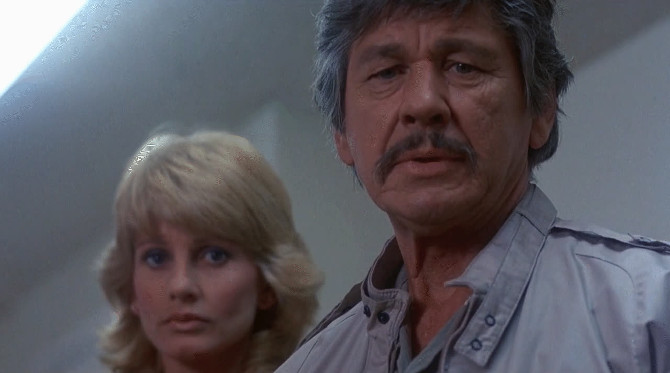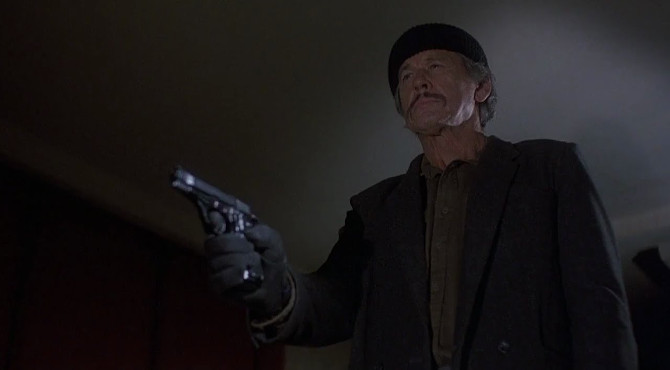Sequels are a fickle matter. Nearly impossible to match the original’s magic in a bottle, they tend to become a greatest hits of the previous effort. . . less story and more about outdoing the first film’s visual antics – attempted appeasement for fans and more fodder for its detractors. This is no different for 1982’s Death Wish II (coming to theatres a lengthy eight years later), director Michael Winner and star Charles Bronson coming together for another vile look at the seedy side of big city America.
Set two years after the original, Paul Kersey (Bronson) has uprooted from New York to Los Angeles. . . the architect finding love once more, this time in the arms of reporter Geri Nichols (Jill Ireland – Bronson’s wife and frequent collaborator – a whopping 16 times). His daughter Carol (Robin Sherwood), after the heinous acts seen in the first film, is slowly making progress with her doctors – at least uttering a few quiet sentences each week.
Yet, the move proves to bring no more safety for the father and daughter, for those lurking on the city streets of L.A. don’t hold the panicked fear that comes with knowing that a violent vigilante is looking for his latest criminal. This leads a group of five hoodlums (one of which is played by Laurence Fishburne – in only his fifth role) to pick on the suited Kersey, stealing his wallet and deciding to surprise the man at his home. . . instead finding his housekeeper (Silvana Gallardo), they rape and kill her, only to then kidnap his daughter.
Of course, this brings out the vigilante that has been dormant in the man for the past few years. Smartly heading out on the streets with very dark clothing, renting a new secret apartment in the seedier part of town, and carrying his trusty revolver, he aims to track down the culprits one at a time, no matter where they may be. . . or whoever they may be with. As things escalate (and local police fear a vigilante on their hands), they look to New York for help (as their vigilante mysteriously disappeared). This brings back Det. Ochoa (Vincent Gardenia) – the only other call back from the previous picture.
Just as violent as the original effort, screenwriter David Engelbach takes over writing credits and develops a solid enough story (though some may roll their eyes that a similar act would occur to Kersey once again – fans will argue Murphy’s Law. . . another complaint will come with one specific scene where a thug goes through about a dozen cops before getting taken down – ridiculously implausible). Winner, directing Bronson for the fifth time (they would reunite for a sixth and final time for. . . you guessed it, Death Wish 3), keeps the piece grounded. Taut, tense, and quite quickly moving, Kersey is by no means an infallible Bond who never gets touched, instead taking bumps, earning bruises, getting knifed (several times) as well as a few other unwanted surprises in his quest.
Filmed mostly on the dark streets of Los Angeles, Winner and cinematographers Thomas Del Ruth and Richard H. Kline develop a shadowy, silhouetted look for their anti-hero – like a pre-modern Batman who is there to save the day. His shadow is seen through curtains, on walls in human and monstrous form, each time a harbinger of doom for those who live on the dark side of life, ready to envelop them with his boundless, revenge-filled rage.
And though this is a sequel that basically plays by the rules of its predecessor, perhaps its most original aspect is its score by rock god Jimmy Page (who was Winner’s next door neighbour at the time). With an opening blues/rock theme that will melt your face right off, he only further impresses, developing orchestral themes (using very different stringed instruments than his beloved guitar) for the romantic melody that carries Kersey and Nichols, the ominous (slightly psychedelic) premonition of oncoming violence or pain, and an oriental theme for a high above the city dinner, further adding depth of sound by creating diegetic street music heard by the characters while they meander along the moody L.A. streets.
Though, like the original, it may not appeal to everyone, Death Wish II matches its predecessor with a solid enough story, creatively violent kills, and a vigilante that people are still drawn to all these years later. Likewise, like the previous film, in which we watched Jeff Goldblum as one of the degenerates, it is even more entertaining watching Fishburne doing his thing. Wearing space-age sunglasses, magician’s gloves, and, in turn, wielding his knife like a wand, his presence is unnervingly undeniable. Also, it is fascinating to watch the real rough streets of L.A. in all their variety on film – twenty off-duty officers were hired to protect the cast and crew (maybe a vigilante truly was needed at the time). So, don’t break this one off, return once more to see this architect of quietus.




